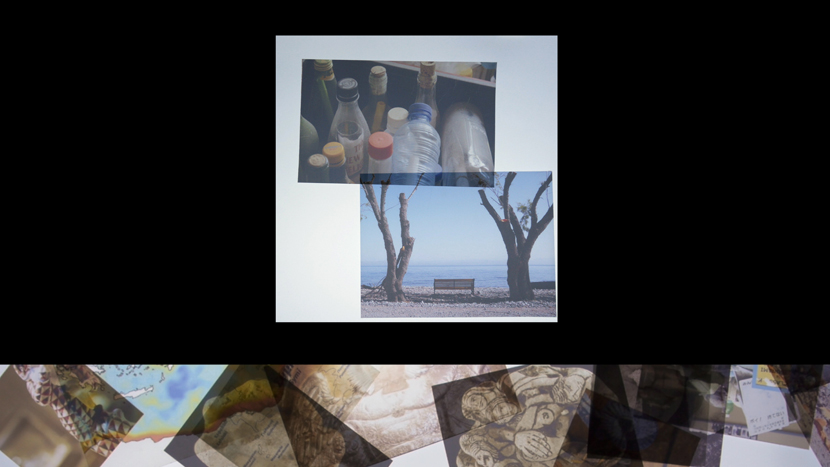
Ellie Ga’s unique 3 part, single channel video is primarily a projection of light tables. In the center of the wall is a square light table and below that a long rectangular light table on which there are a collection of photo transparencies. We watch the artist’s hand shuffle images between the two light tables as she narrates an autobiographical travelogue. She illustrates her story by selecting transparencies from the long horizontal light table and moving them onto the square light table above it. By assembling and layering the images of places and objects on top of each other she creates collages in real time. Both in form and content Gyres is not your typical holiday slide show or ordinary phone scroll of vacation images.
Gyres are circular patterns in the ocean that are formed by currents and as they move along they carry and deposit debris, often very far from its place of origin. Like a gyre Ga takes us on a journey that goes in circles, touching ashore in Washington State and the Greek Islands of Symi and Lesbos, all awhile making surprising connections between ocean currents, oceanography, the meaning of objects in our lives, collecting, illness, the Fukushima nuclear disaster, refugees, debris, and art history. Ga’s video projection is an elegant visual embodiment of the circular flow of water, the things it collects and deposits.
Ga’s travelogue of ideas is part of a literary tradition that includes the hybrid fiction of W.G. Sebald, Rebecca Solnit’s essays, and the travel stories of Bruce Chatwin, whom she references in the work. Gyres also reminded me of Rachel Cusk’s Outline, a novel in which a writing teacher, on a trip to Greece, encounters various characters who tell her their stories and in doing so form for the reader an outline of the narrator herself.
Like her literary counterparts Ga converses with characters who have surprising backgrounds, a geologist, a cop turned refugee volunteer, a curator of a museum of the exile. She recounts their stories and by doing so deepens our understanding of her own story. As we journey with her, we see how seemingly unrelated things like a religious icon, a seacombers convention, and the death of her mother become meaningfully connected through her deeply personal way of collecting and arranging images and stories.